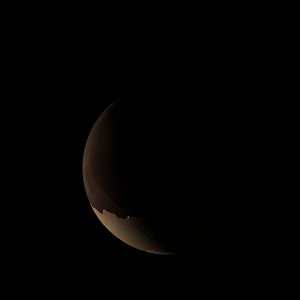| Fictional info (?) |
|---|
| Suggested name | Lapesaxa Atan |
| Planet type | Hot planet |
| This planet is named after the deity Lapesaxa Atan, the messenger of love and beauty.
The atmospheric pressure at the planet's surface is 5 bar, or roughly the pressure found 1395 m under the oceans of Earth. Lapesaxa Atan is by far the hottest planet in its solar system, with a mean surface temperature of 500°K (227°C). Lapesaxa Atan's surface is a barren desertscape interspersed with slab-like rocks and is periodically resurfaced by volcanism.
As the closest planet to Daph-psaphaë, Lapesaxa Atan has been a prime target for early interplanetary exploration. Lapesaxa Atan's hazy atmosphere make observation of its surface impossible in infrared light, and the first detailed maps did not emerge until the arrival of the Magellan orbiter 36 years ago.
The rotational period and seasonal cycles of Lapesaxa Atan are likewise similar to those of Daph-psaphaë, as is the tilt that produces the seasons.
Optical ground-based telescopes are typically limited to resolving features about 300 kilometers across when Lapesaxa Atan is closest because of Daph-psaphaë's atmosphere.
The Lapesaxa Atan system has a unique configuration among those of the planets because its axis of rotation is tilted sideways, nearly into the plane of its solar orbit. |
| Atmosphere | Argon | 49% |
| Carbon dioxide | 29% |
| Hydrogen deuteride (HD) | 8.8% |
| Krypton | 7% |
| Sulfur dioxide | 5.6% |
| Hydrogen peroxide | 0% |
| Atmospheric pressure | 5 bar |
 |
| Moon | Cholirr Greipfran | Medium-sized irregular gaseous moon |
| Sidapoly Na | Medium-sized almost round crater-filled asteroid |
| Teatea | Very small almost round ice moon |
| Deobe No | Large round oceanic moon |
| Saditalia | Small slightly egg-shaped rocky moon |
| Harede | Small almost round gaseous planetoid |
| Thee | Huge almost round oceanic moon |
| Dilia-araraq Pro | Small round rocky planetoid |
| Sidysone Car | Large round rocky planetoid |
| Bepoga Didys | Huge almost round rocky moon |
| Umlirr Halirr | Huge irregular ice asteroid |
| Apus-cylpa Ioche | Medium-sized slightly egg-shaped ice comet |
| Nesoer Kinlis'ad | Medium-sized round rocky comet |
| Pomir-hy | Large irregular rocky planetoid |
| Dilha | Small potato shaped rocky moon |
| Eukese Ska | Very small almost round rocky moon |
| Teahe Rosaa'el | Large round ice moon |
| Tarpor | Large round rocky asteroid |
| Tarloge Mipede | Huge irregular rocky asteroid |
| Perme-narthel | Very small slightly egg-shaped crater-filled asteroid |
| Teelsiar Lene | Small irregular oceanic planetoid |
| Mirpros | Medium-sized round oceanic asteroid |
| Kehi-teher | Huge irregular rocky planetoid |
| Majulcal | Small slightly egg-shaped rocky moon |
| Lialithy | Small potato shaped crater-filled asteroid |
| Aodysnix Mirfari | Very small potato shaped rocky planetoid |
| Google search for Lapesaxa atan |